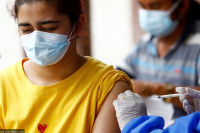Health
Nepal drops plan to expand maternal and perinatal death tracking
Officials say tight budget prevents scaling up vital health programmes, and even when new programmes are approved, funds are halted later.
Post Report
The Family Welfare Division under the Department of Health Services has not proposed expanding the maternal and perinatal death surveillance programme for the upcoming fiscal year citing the budget ceilings that leave no room for scaling up existing healthcare programmes.
Officials say that even if new health care programmes are designed, it is very difficult to convince officials to allocate a budget, and even if budgets are allocated, most of the time, they are later asked to scrap the programme.
“We all know that budgets are made not on the basis of realistic assessment of the country’s economic health and this makes it difficult to achieve targets,” said an official in condition of anonymity, as he is not authorised to speak to the media. “When they [government] cannot release funds for crucial programmes, they ask to cancel such programmes.”
Maternal and perinatal death surveillance is a key intervention for improving maternal, perinatal, and neonatal survival. Experts say such surveillance helps identify the causes of death.
The World Health Organisation said that maternal and perinatal death surveillance and response (MPDSR) is an essential quality improvement intervention, which permits the identification, notification, quantification and determination of causes and avoidability of maternal and neonatal deaths and stillbirth with the goal of orienting the measures necessary for their prevention.
According to the UN health body, systematic analyses of overall mortality trends, as well as events and contributing factors leading to individual deaths, can identify barriers in health systems and inspire local solutions to prevent such deaths in the future.
“The primary goal of MPDSR is reducing future preventable maternal mortality through a continuous action and surveillance cycle followed by the interpretation of the aggregated information on the findings, which is used for recommended actions to prevent future deaths,” says the WHO.
Nepal has committed to reducing maternal and neonatal deaths, but the MPDSR programme has not been implemented nationwide.
So far, the programme has been launched in only 51 districts. Officials say maternal and perinatal deaths are monitored only in the districts which have been implementing the MPDSR programme.
“We were directed not to plan any new programme at the time the budget ceiling was given to us,” said Nisha Joshi, an official at the division. “We did not plan the extension of the MPDSR programme this time.”
The government has allocated Rs95.81 billion for the health sector for the upcoming fiscal year—Rs9.57 billion more than the allocation for the current fiscal year and around Rs13 billion over the ceiling set during budget preparation.
Officials say even if the budget allocation has risen, it is not for new programmes but to reimburse past dues. Maternal health experts say that without the MPDSR programme, ongoing maternal and perinatal deaths cannot be prevented effectively.
“How can the ongoing deaths of mother and newborn be prevented, when health workers do not know the real cause of the deaths and complications,” said Dr Aruna Karki, a consultant gynaecologist at the Kathmandu Model Hospital. “The MPDSR programme not only explores the real causes of maternal and perinatal deaths but also helps design action plans to avoid similar cases in the future.”
Excessive bleeding after childbirth, pre-eclampsia and eclampsia (pregnancy-related high blood pressure disorders) have been identified as some of the major causes of maternal deaths in Nepal. Likewise, prematurity (neonates born at less than 37 weeks' gestation), birth asphyxia (a condition in which a baby does not receive enough oxygen before, during, or directly after birth), and sepsis (organ dysfunction caused by a dysregulated host response to infection) are considered major reasons for neonatal deaths.
Maternal and child health experts say unless the causes of deaths of mothers and babies are determined, it is impossible to reduce the mortality rates. This makes maternal and perinatal death surveillance extremely important, according to them.
Nepal has reduced maternal deaths by over 70 percent since 2000, according to a report by the World Health Organisation.
The UN health body, in its report, stated that currently 142 Nepali women die from maternity-related complications per 100,000 live births.
A previous study carried out by the National Statistics Office in 2021 had shown 151 maternal deaths per 100,000 live births. Similarly, neonatal mortality now stands at 16.6 per 1,000 live births, and the stillbirth rate has decreased to 13.5 per 1,000 births.
The Nepal Demographic and Health Survey-2022, carried out by the Ministry of Health and Population, showed that 21 neonates die per 1,000 live births.
The health target under the UN’s Sustainable Development Goals is to reduce the maternal mortality rate to 75 for every 100,000 births by 2030.
SDGs, a follow-up on the Millennium Development Goals (MDGs), aim to end poverty and hunger and all forms of inequality in the world by 2030, and Nepal has committed to meeting the goals.




 18.12°C Kathmandu
18.12°C Kathmandu













